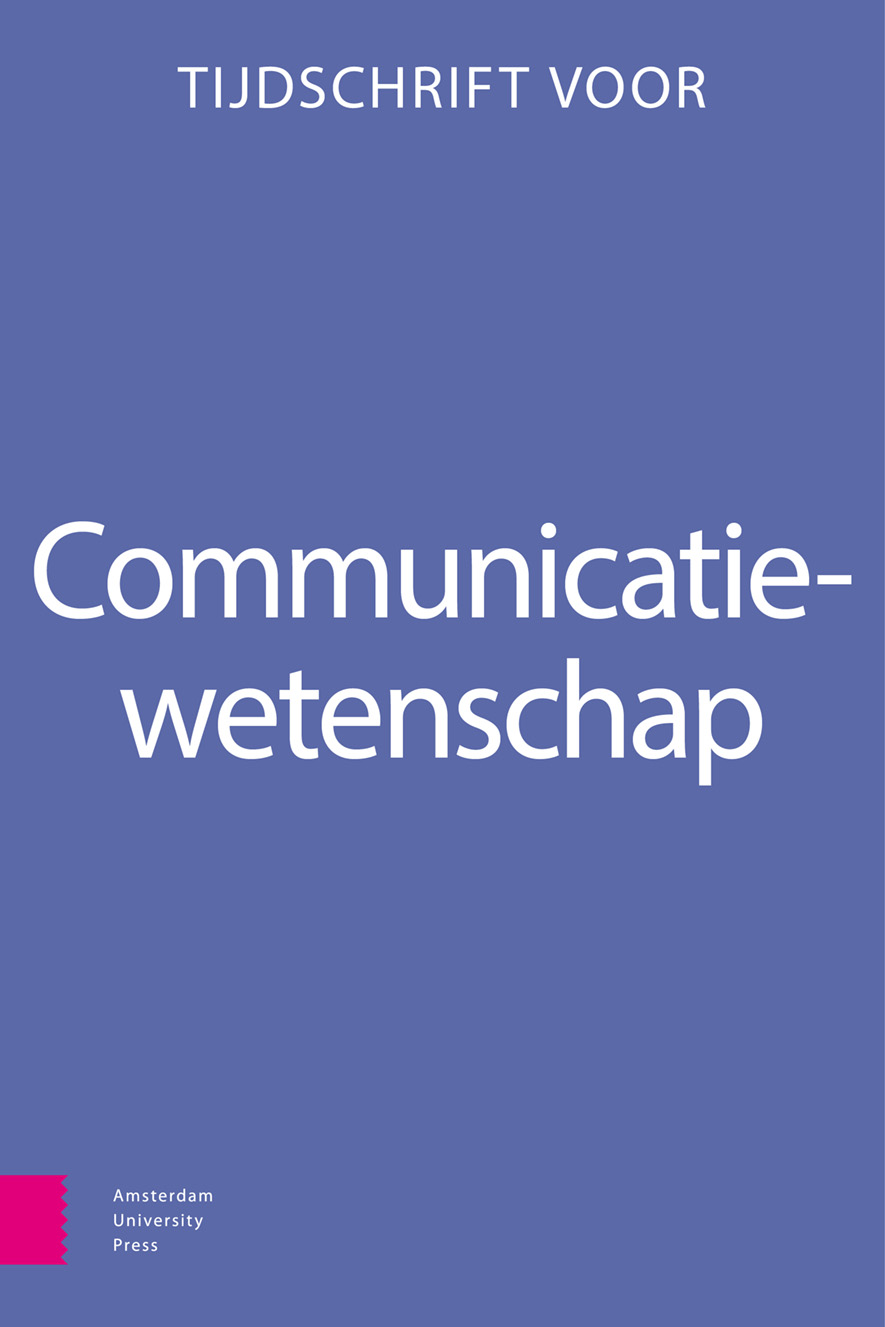- Home
- A-Z Publicaties
- Tijdschrift voor Communicatiewetenschap
- Previous Issues
- Volume 46, Issue 4, 2018
Tijdschrift voor Communicatiewetenschap - Volume 46, Issue 4, 2018
Volume 46, Issue 4, 2018
Taal:
Nederlands
-
-
Redactioneel
Meer MinderAuteurs: Marieke Fransen & Stijn JoyeHet jaarlijkse Etmaal van de Communicatiewetenschap deed in 2018 voor een tweede maal in haar geschiedenis Gent aan. Onder het goedkeurende oog van The Netherlands and Flanders Communication Association (NeFCA), was de vakgroep Communicatiewetenschappen van de Universiteit Gent een trotse gastheer voor de twintigste editie van de jaarlijkse academische hoogmis van Vlaamse en Nederlandse com Read More
-
-
-
Drie keer hetzelfde, maar anders
Meer MinderAuteurs: Eduard Cuelenaere, Gertjan Willems & Stijn JoyeSamenvatting Focussend op de Belgische, Nederlandse en Amerikaanse filmversies van Loft bestudeert dit artikel de relaties tussen interculturele mediapraktijken en de (re)producties van culturele identiteiten. Een vergelijkende tekstuele en contextuele filmanalyse van representaties van vrouwelijke personages, seksualiteit en etniciteit illustreert dat de verschillende versies van eenzelfde filmverhaal gerelateerd zijn aan h Read More
-
-
-
Kwaad in vele vormen
Meer MinderDoor Lennart SoberonSamenvatting In dit artikel wordt de representatie van held- en vijandpersonages in de Amerikaanse actiefilm onderzocht. Aan de hand van een kwantitatieve inhoudsanalyse wordt nagegaan op welke variabelen van identiteit structuren van verschil en vijandschap geënt zijn binnen het genre. Naast variabelen gerelateerd aan identiteit werden ook de handelingen, motieven en vormelijkheden van beide typen personage Read More
-
-
-
Wat is de modererende invloed van milieubetrokkenheid op de effectiviteit van visuele versus tekstuele groene labels?
Meer MinderAuteurs: Paola Remmelswaal, Marijn H.C. Meijers & Naomi VonkSamenvatting Groene labels op producten hebben een spillover-effect op de koopintentie van groene producten in het algemeen, afhankelijk van type label en milieubetrokkenheid. Visuele (vs. tekstuele) groene labels zijn effectiever voor consumenten met een lage milieubetrokkenheid, terwijl voor consumenten met een hoge milieubetrokkenheid beide labels effectief zijn. Er was geen interactie-effect op de productattitude of k Read More
-
-
-
‘Meet the blockers’
Meer MinderAuteurs: Glen Joris, Karolien Poels, Peter Mechant, Sara Pabian & Lieven De MarezSamenvatting Een steekproef bij 400 Vlaamse jongere personen van 16 tot 30 jaar toont aan dat de attitude tegenover ad blockers de meest belangrijke voorspeller vormt om verschillen te verklaren in de intentie om ad blockers te gebruiken. Minder bezorgdheden omtrent privacy, minder storing en minder data en kosten vormen de meest belangrijke gedragsopvattingen.
-
-
-
Framing Google
Meer MinderAuteurs: Judith Knuvers, Steven Malliet & Pieter MaeseeleSamenvatting Dit artikel presenteert de resultaten van een kwalitatieve framinganalyse van de berichtgeving over online privacyschending door Google door zowel een traditioneel journalistiek product, de krant NRC Handelsblad, als een alternatief, digitaal journalistiek platform, De Correspondent (N = 68). Hieruit komen twee duidelijk van elkaar te onderscheiden frames naar voren die het debat in beide nieuwsmed Read More
-
-
-
Summaries
Meer Minder[Glen Joris, Karolien Poels, Peter Mechant, Sara Pabian & Lieven De Marez ‘Meet the blockers’. Youth, young adults and automatic ad avoidance online Ad blocking – the use of browser extensions such as Adblock (Plus) or Ublock – is becoming mainstream, particularly amongst young web users. This automated form of advertising avoidance has attracted significant attention due to the loss of advertising revenues. Insights i Read More
-
-
-
Dankwoord
Meer MinderIn jaargang 46 zijn achttien peer reviewed artikelen gepubliceerd. Deze jaargang bevat een special issue (nummer 1): Journalism studies en een themanummer (nummer 4): het ‘traditionele’ Etmaal-nummer. Alle auteurs en gastredacteuren danken we voor hun bijdragen aan het Tijdschrift voor Communicatiewetenschap.
-
Volumes & issues
-
Volume 53 (2025)
-
Volume 52 (2024)
-
Volume 51 (2023)
-
Volume 50 (2022)
-
Volume 49 (2021)
-
Volume 48 (2020)
-
Volume 47 (2019)
-
Volume 46 (2018)
-
Volume 45 (2017)
-
Volume 44 (2016)
-
Volume 43 (2015)
-
Volume 42 (2014)
-
Volume 41 (2013)
-
Volume 40 (2012)
-
Volume 39 (2011)
-
Volume 38 (2010)
-
Volume 37 (2009)
-
Volume 36 (2008)
-
Volume 35 (2007)
-
Volume 34 (2006)
-
Volume 33 (2005)
Most Read This Month
Article
content/journals/13846930
Journal
10
5
false
nl


